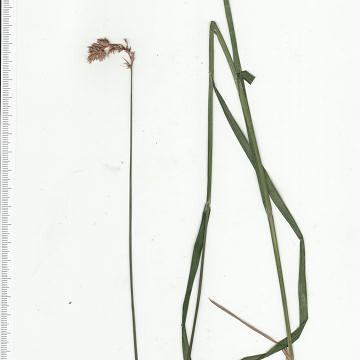

Carex tribuloides - (image 1 of 6)
Taxonomy
Family: Cyperaceae
Section Ovales
Habitat
Wet woods, marshes, floodplains, ditches, and meadows. Found in more open areas than C. projecta.
Associates
Swamp white oak and other associates of standing water like vernal pools and intermittent streams.
Distribution
Quebec and ME to MN and NE, south to FL, LA, and OK. More common in the south.
Morphology
Tufted perennial, aphyllopodic; stems stout, to 1 m; sheaths ventrally green-veined nearly to the summit; leaves 3-7 mm wide, shorter than the stems; spikes 5-15, gynaecandrous, subglobose to obovoid, 6-12 mm, usually blunt, rounded to acute at the base, densely or loosely collected in an ovoid or oblong cluster 2-5 cm long; perigynia usually over 30, appressed-ascending, green to stramineous, 4-5 x 1-1.3 mm, 3-4 times as long as wide, lanceolate, flat or somewhat distended over achene, wing narrowed somewhat abruptly near the middle and often absent on the lower fourth, obscurely nerved on both sides, gradually tapering into beak; achene lenticular, 1.5 mm long and 0.5-0.75 mm wide; stigmas 2.
Notes
Fruiting June to July
Wetland indicator: FACW
Closely related to C. projecta which has shorter spikes (5-8 mm) that are less crowded (often separated below) with less than 30 perigynia per spike. Specimens of C. scoparia might key to this species is some of the perigynia are not winged below the middle, but it has leaves that are always less than 3 mm wide. Sometimes confused with C. cristatella which has spikes that are more spherical.
References
Curtis, L. 2006. Woodland Carex of the upper Midwest. Lake Villa, IL.
Gleason, Henry A. and A. Cronquist. 1991. Manual of Vascular Plants of
Northeastern United States and Adjacent Canada. Second Ed.
The New York Botanical Garden. Bronx, NY
Swink, F. and G. Wilhelm. 1994. Plants of the Chicago Region.
Indiana Academy of Science. The Morton Arboretum. Lisle, Illinois.
|
© Michael Hough 2010 |